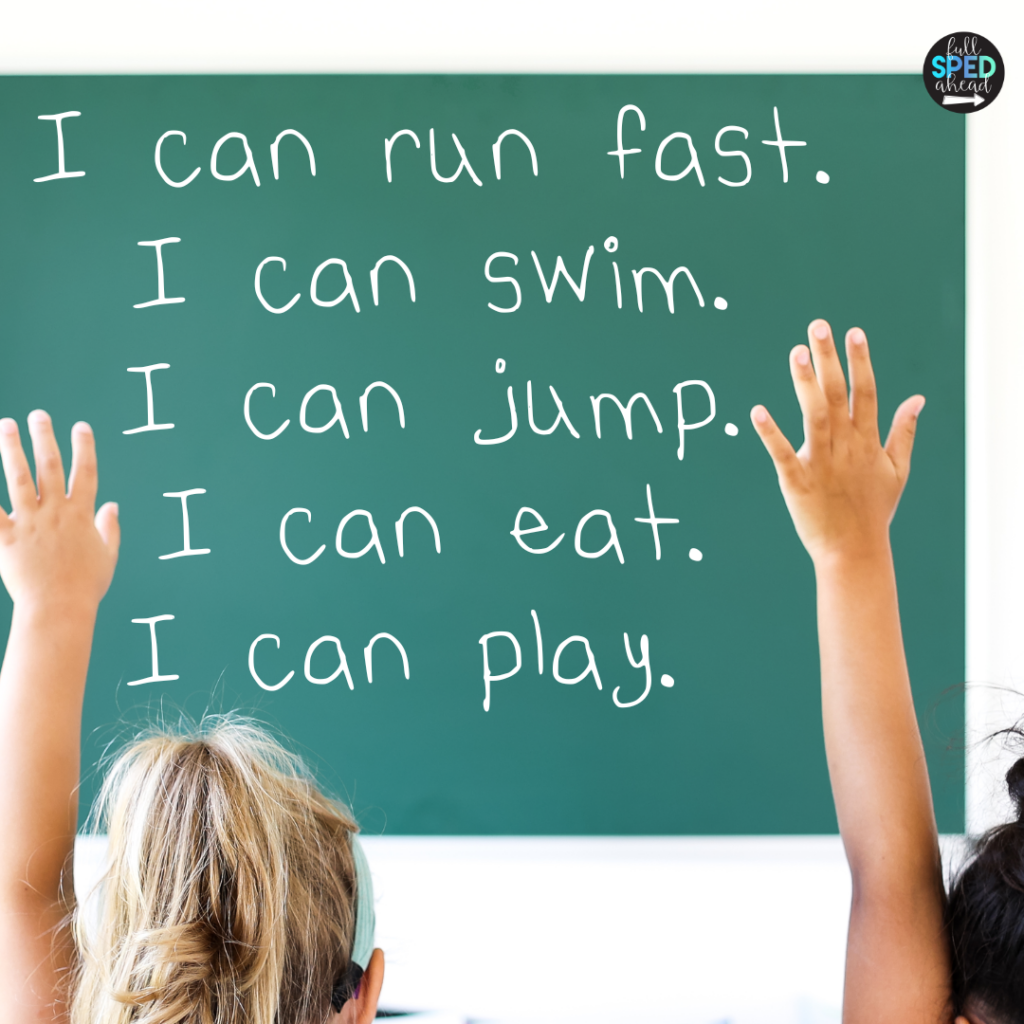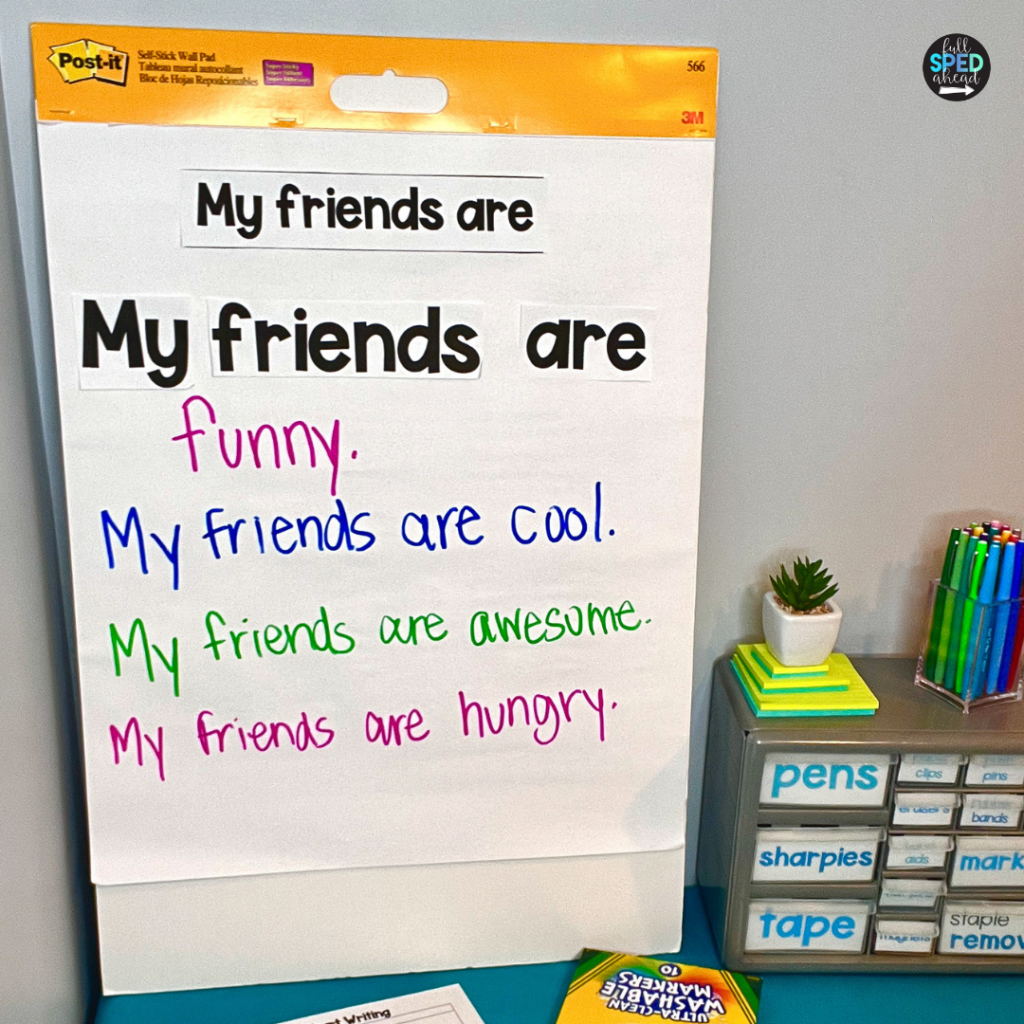Augmentative and Alternative Communication (AAC) has revolutionized how educators support students with communication challenges, offering a bridge to more effective interaction and learning. Among the myriad applications of AAC in the classroom, its role in the writing process stands out as particularly transformative. This blog post explores how teachers can leverage AAC and predictable chart writing to support their students during writing activities. Let me teach you the ways to bring AAC and predictable chart writing together!
Read more about AAC & Predictable Chart Writing

AAC encompasses various tools and strategies used to aid communication for individuals who find verbal speech difficult. These can range from low-tech options like picture cards and communication boards to high-tech solutions such as speech-generating devices and specialized software. Is predictable chart writing the answer?
GRAB 4 WEEKS OF PREDICTABLE CHART WRITING LESSONS FOR FREE
The integration of AAC and predictable chart writing instruction provides students with a means to express their thoughts, participate in classroom activities, and develop literacy skills. By giving students access to AAC, teachers can create an inclusive environment where every student has the opportunity to contribute and succeed. This is a great way to bring AAC and predictable chart writing together!

Predictable chart writing is a collaborative and structured approach to writing that involves creating sentences based on a common sentence starter. This technique is particularly beneficial for students who use AAC, as it provides a predictable and supportive framework for writing.
Make sure to grab this resource
Step 1: Introducing the Sentence Starter
Begin by introducing a sentence starter prompt. Choose a simple and engaging starter that is relevant to the students’ interests or current classroom themes. For example, “I like to…” or “In the park, I see…” You can always model on AAC and predictable chart writing strips to support students understanding. You can use AAC and sentence stems to bring it all together.
Step 2: Modeling the Process
Model the process of creating sentences with the chosen starter. Use a whiteboard or large paper to demonstrate how to form a complete sentence. Involve your staff in this step to show various ways of completing the sentence, ensuring that students see multiple examples.
Step 3: Student Participation
Invite students to fill in their sentences verbally or by using their AAC devices. Encourage them to think creatively and use vocabulary they are familiar with. For students who might struggle, provide additional support by suggesting words or phrases they can use.

Step 4: Class Review
Once all students have completed their sentences, read through each one as a class. This reinforces the content and allows students to hear their peers’ contributions, fostering a sense of community and collaboration.
Step 5: Sentence Strips
Before the next class, write each student’s sentence on a sentence strip. During the review session, have students find their sentence strip. This helps reinforce recognition and ownership of their work.
Step 6: Cutting and Reassembling
Provide students with the opportunity to cut their sentence strips apart. With or without a written model, students can practice putting their sentences back together in the correct order. This activity helps develop sequencing skills and reinforces their understanding of sentence structure.
Step 7: Reading and Illustrating
Have students read their sentences in the correct order. To make the activity more engaging, use the internet to find pictures that relate to their sentences, or have students draw their own illustrations. This visual component enhances comprehension and makes the writing process more meaningful.
Step 8: Presentation and Book Creation
Students then share their sentences and pictures with the class, promoting confidence and communication skills. Finally, compile the sentences and illustrations into a class book. This not only showcases their hard work but also serves as a tangible reminder of their progress and achievements. This is a great way to bring AAC and predictable chart writing together!

AAC and Predictable chart writing offers a powerful and inclusive strategy for supporting students in the writing process. By providing a structured framework and leveraging the benefits of AAC, teachers can empower their students to express themselves, participate actively in classroom activities, and develop essential literacy skills. Embracing these techniques not only enhances academic outcomes but also fosters a supportive and collaborative classroom environment where every student can thrive. Are you going to try pairing AAC and predictable chart writing?
What are you looking for?
COPYRIGHT © 2025 Full SPED Ahead